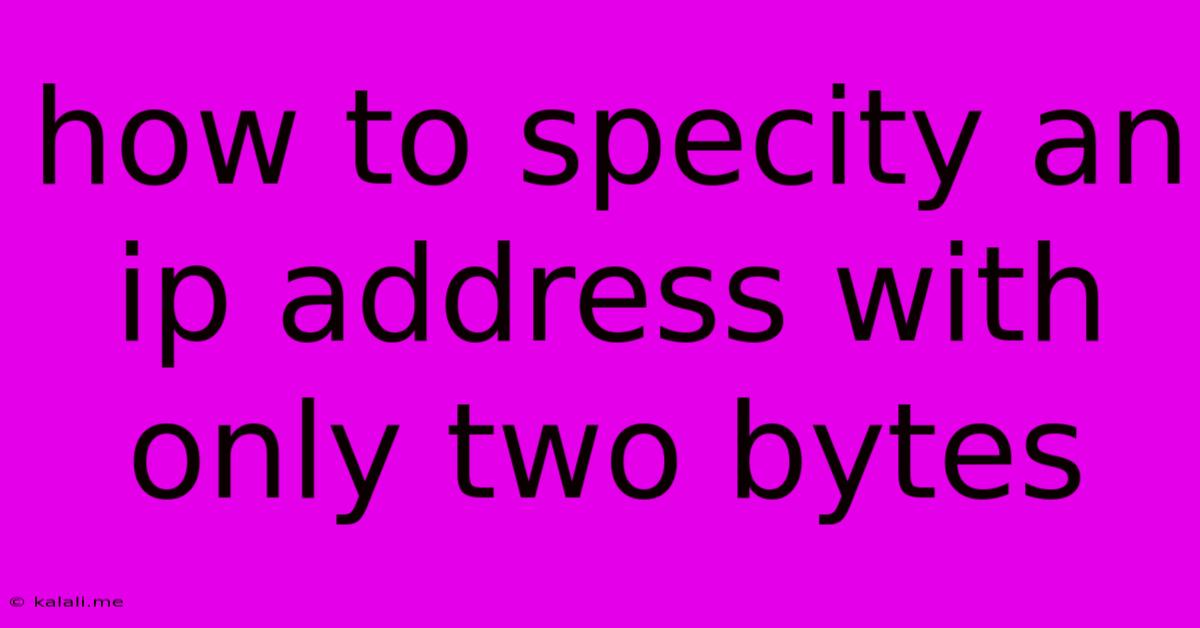How To Specity An Ip Address With Only Two Bytes
Kalali
Jun 02, 2025 · 3 min read

Table of Contents
Specifying an IP Address with Only Two Bytes: Understanding Subnetting and CIDR Notation
This article explains how you can seemingly specify an IP address using only two bytes, though it's crucial to understand this isn't a direct representation of the full IP address but rather a shortcut within a specific subnetwork. This method leverages subnetting and CIDR notation to dramatically reduce the number of bytes needed to identify a device within a known network segment. Understanding subnets is key to grasping this concept.
A standard IPv4 address consists of four bytes (32 bits) represented in dotted decimal notation (e.g., 192.168.1.10). However, by utilizing subnetting, we can effectively represent an IP address within a subnet using fewer bytes. This is particularly useful in large networks where addressing individual devices using the full four bytes becomes cumbersome.
Understanding Subnetting and Network Masks
Subnetting divides a larger network into smaller, more manageable subnetworks. This division is achieved using a subnet mask, which determines how many bits of the IP address are used to identify the network portion and how many bits are used to identify the host portion.
For example, a Class C network (typically 192.168.1.0/24) uses the first 24 bits to identify the network and the remaining 8 bits for host addresses. The /24 is CIDR notation, indicating the network prefix length.
Specifying an IP with Two Bytes: The Practical Application
Let's say we're working with the 192.168.1.0/24 network. Since the first three bytes (192.168.1) are identical for all devices in this subnet, we only need to specify the last byte (the host portion) to uniquely identify a device. This means we can effectively specify an IP address using only two hexadecimal digits (one byte) or, for simpler readability, the decimal equivalent (0-255).
For instance, instead of writing 192.168.1.10, we could refer to it as simply 10 (decimal) or 0A (hexadecimal) within the context of the 192.168.1.0/24 network. This is a simplification made possible because the network portion of the address is already known.
Important Considerations:
- Context is Crucial: This "two-byte" representation is only valid within the context of the pre-defined subnet. Outside of that subnet, it's meaningless.
- Network Mask: You must always know the network mask or CIDR notation to interpret the abbreviated IP address correctly.
- Limitations: This technique doesn't reduce the actual number of bits used to represent the IP address, it just simplifies the way we refer to it within a known network segment.
Practical Examples
Let's consider another example: a /16 network, such as 10.0.0.0/16. In this case, we can use the last two bytes (two bytes total, expressed as four decimal digits separated by a dot) to pinpoint a device's location within this subnet. For example, 10.0.10.20 is expressed using two bytes relative to the /16 network.
Conclusion
While you can't technically specify a full IPv4 address using just two bytes, using subnetting and CIDR notation allows for a shorthand representation within a particular subnet. This simplifies network management, especially in large networks. Always remember the context and the subnet mask are vital for correctly interpreting these abbreviated addresses. Misunderstanding the subnet will lead to incorrect address resolution and network connectivity issues.
Latest Posts
Latest Posts
-
Add Line Break Between Checkbox Items
Jun 04, 2025
-
Are There Studs In The Ceiling
Jun 04, 2025
-
Who Can I Pay To Make A Game
Jun 04, 2025
-
How Much Prime Rib Roast Beef Per Person
Jun 04, 2025
-
Fallout 4 How To Connect Power To Lights
Jun 04, 2025
Related Post
Thank you for visiting our website which covers about How To Specity An Ip Address With Only Two Bytes . We hope the information provided has been useful to you. Feel free to contact us if you have any questions or need further assistance. See you next time and don't miss to bookmark.